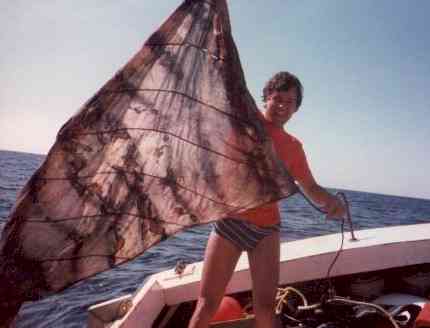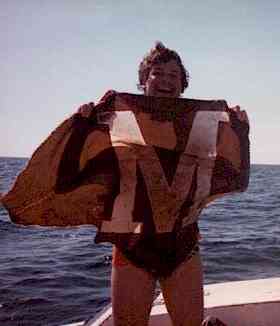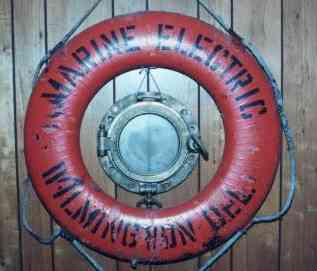13 February 1981
The morning news reported a ship sunk during
the night off Norfolk. This was somewhat unusual, but off Norfolk
can mean a large area or even the closest reporting organization.
By the end of the day the reports were becoming more specific
on the location and relation to the severe storm that had lashed
the Maryland and Virginia coast on Thursday. Soon there were
sparse reports of the Norfolk and Chincoteague Virginia Cost
Guard rescue attempts. However there still was no report of survivors;
the ship had vanished on its run from Norfolk to New York.
We had been scuba diving the East Coast
from New Jersey to North Carolina for nine years, mostly on World
War II shipwrecks. The mid-Atlantic Ocean has mostly sandy bottom
with very few reefs thereby leaving only shipwrecks for scuba
diving. Ship wrecks newer than the war were few and I had not
heard of one within diving depth since I started diving in the
1960’s. The most recent had been the Marjory McAlester,
an ocean tug lost off Cape Lookout in 1969 and the Ethyl-C off
Cape Henry the same year.
Several months had passed when I met the
husband of a friend; a Navy Seal stationed in Norfolk. Later
that night the subject of diving came up and he started to tell
us the story of his Seal team efforts to rescue the crew of the
Marine Electric. The whole story took an hour and although he
had not been part of the team, many of his friends had. It was
a brave attempt in weather so severe that passage and anchoring
were risky, much less diving into the wreck in heavy seas. Until
that time I was not even aware of the exact location of the disaster,
much less the fact that it only lay in 130 feet of water just
off Chincoteague, one of out favorite diving areas.
With early May came the good weather and
the start of dive season. Also came word that two of our charter
captains knew of the location of the Marine Electric, although
it was a longer boat ride that usual. First we tried from Chincoteague,
but the boat developed engine problems half way out and the Captain
returned inshore not wishing for a total breakdown that far off-shore.
As June of 1981 approached, our Ocean City charter captain told
us he knew the location and wanted to go there on the next charter.
He ran a large (60 foot) crew boat and it would be the perfect
dive boat for that trip. By this time, there were many stories
of the Marine Electric including the investigations into the
cause of the sinking and some salvage attempts for the large
Bronze propeller. Also by that time we knew it was broken in
two and the short section was the stern where the bridge and
crew quarters were located. The insurance divers reported the
bow section upside down and the stern lying on her side.
Finally one Saturday in early June we headed
to the SS Marine Electric. We were not the first to go there
by then and stories came with details of no visibility, cold
water and lots of coal dust. In general, it was not a nice dive
and not one for a novice. The Marine Electric had been carrying
6,000 tons of fine coal slurry (pea size and smaller) which now
enveloped the wreck already lying in a silty bottom area. By
now the water was starting to warm up, at least on the surface,
but the bottom would still be in the low 40’s. The captain
anchored his boat; "The Good Time Diver" in the area
that he thought would be the stern. We geared up in out wet suits,
scuba tanks for the 130 foot descent and having no idea what
to expect - expect bad to no visibility. On dives like that even
the brightest dive lights are of little help. Today the cold
water stayed bright all the way down and by the time my wife
Penny and I reached the wreckage we still had more than 15 feet
of visibility.
Usually as I explore an old steel wreck
I have visions of the explosions and fire that sunk so many during
the war. Then came depth charging by the navy looking for German
U-Boats, followed by navigational clearing with explosives and
wire drags. After the war many were salvaged for copper and brass
and many were blown in one way or another. So I was used to seeing
twisted wreckage, sometimes unrecognizable. The hurricanes do
more than their share when they send ground swells all the way
to the bottom and over the years most ship wrecks experience
recurring damage. I was never able to sort out the cause of the
damage. In this case the wreck was new. No one had blown it up
and there had been no major storms or Hurricanes. I expected
to see an intact ship.
We were anchored near the stack where it
met the deck area and the scene met my expectations. However
I soon noticed that the bridge area was in shambles. Most windows
were broken with thick glass pieces hanging in the frames. There
was twisted and confusing wreckage all around. The bridge was
half full of sand with only part of the large radar protruding.
The sand level was just at the middle of the bridge. Even the
helm was not recognizable. Then I remembered the large stack
with the big black diamond and white "M" was also half-buried
and parallel to the sand. The entire stern had sunk exactly half
way into the sand with the deck vertical to the bottom.
I swam through a door near the bridge that
was also horizontal; every thing recognizable was horizontal
from the norm. The first room appeared to be a galley as it had
several tables attached to the floor, which I perceived as a
wall. I cautiously entered a hall worrying about the loose wires
and other strange clutter. I looked into a room and saw furniture
with light streaming through a single closed porthole. I investigated
some more looking in another room. It too had a porthole, but
sand was packed against it. I later realized I must have been
at least 15 or 20 feet below the level of the ocean bottom outside.
I returned to the hallway leading out worrying about loosing
my sense of direction without a safety line. With the welcome
light of outside I noticed an orange life ring on the ceiling.
I pulled on it. There was so must bouyency that at first I though
it must be attached to the wall. I started to leave and then
remembered that it must have the ships name on it. Few things
last very long containing the name. I pulled and stood it on
end looking at the back with my light. There it was clearly "Marine
Electric Wilmington Del". My wife and long time dive buddy
waited above the railing outside. I rolled the life ring to the
edge and let it fly toward the surface zooming past her face.
The crew on the boat said the ring leaped in the air upon surfacing
and laid next to out boat. They reached overboard and retrieved
it reading the name more clearly than I had in the darkness on
the bottom.
Although 130 feet is not very deep for
sport diving, it still is very limiting for safe duration and
ours was all too quickly reached. Penny and I returned to the
anchor line and ascended to 20 feet for the first of two decompression
stops before returning to the boat. The sun was warm and we soon
warmed up while comparing stories of what the ship looked like.
Everyone was a bit confused by the damage and twisted steel.
Several divers had investigated the area just forward of the
bridge windows and reported twisted metal for a few feet and
then no more wreck. The break had been just in front of the bridge
and must have accounted for the magnitude of the damage in that
area.
After more than two hours and a good lunch
we re-suited and made the second dive that is usually shorter
than the first due to the residual nitrogen acclimated in the
first dive. Calculating the length of the second dive is based
on surface time since the first. We had only fifteen minutes
on the second exploration. Once again we went in the bridge area
still having trouble understanding the jumble. Only the signal
flag box and the radar seemed to make any sense. Returning outside
I decided to explore the deck area rather than go inside, due
the shortness of the dive, which was almost over. Near the bridge
was a mast and lots of cable. Everything was twisted around something
and I was doing my best no to join the mess. I stopped to look
at my dive timer as the planned departure time was approaching
fast. I leaned against the mast and noticed a dark object wrapped
around it. Must be one of those signal flags, but why would there
be a signal flag flying from the mast? Despite my shortness of
time I untwisted the thick nylon from the steel cable which itself
was twisted around the mast. Penny was waving bye-bye as she
returned on time. I shown my light on the thick wrinkled material
illuminating a big white "M" - the same symbol I had
seen on the side of the stack. I was failing to understand how
it was attached to the cable and my time was overextended. I
cut the material as close as I could to the steel cable and stowed
the flag in my bag where it would safely ride out the return
trip to my first decompresson stop.
On the deck of the dive boat I saw Penny.
She was already out of her gear and waiting for me to return.
With some excitement, I said, "I have a flag". She
said, "don’t bother, John brought one of those signal
flags up and it is rotting cotton...throw it back". Well
I knew it was not a signal flag, nor made of cheap rotting cotton.
I pulled it out and held it up, "it’s the ships flag!".
Several years later a friend looked at it and commented: "What’s
so spectacular about that artifact is that is makes me realize
that ships still sink. It should be on display somewhere."
The ship's flag with the big white "M"
that was flying from the mast when the ship sunk in now on display
in the lobby of MEBA where many of the crew were trained.
Doug and Penny Buckley
November 1996
 Cotton signal flag
Cotton signal flag
 Nylon ship's slag flying from the mast
Nylon ship's slag flying from the mast
 Lifering from galley area in stern
Lifering from galley area in stern
Back to the Library
